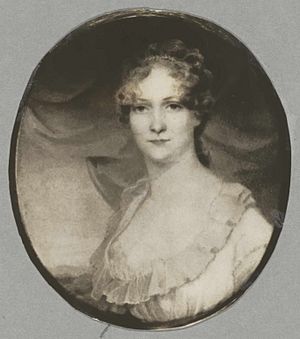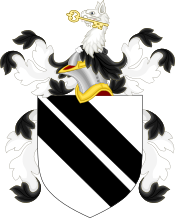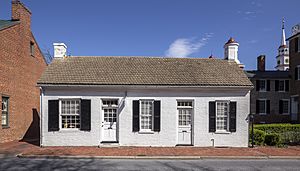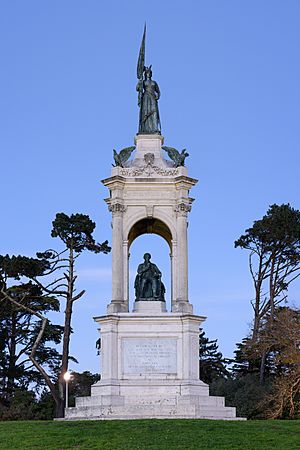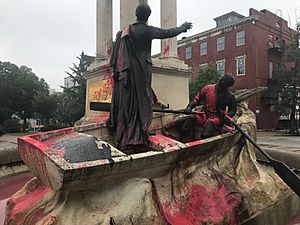Francis Scott Key facts for kids
Quick facts for kids
Francis Scott Key
|
|
|---|---|
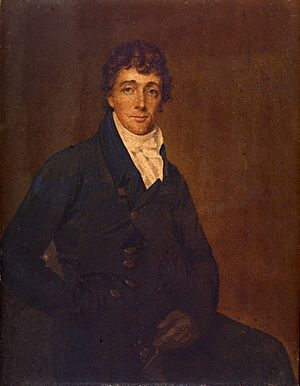
Key c. 1825
|
|
| 4th United States Attorney for the District of Columbia | |
| In office 1833–1841 |
|
| President | Andrew Jackson Martin Van Buren |
| Preceded by | Thomas Swann |
| Succeeded by | Philip Richard Fendall II |
| Personal details | |
| Born | August 1, 1779 Frederick County, Maryland (now Carroll County), US |
| Died | January 11, 1843 (aged 63) Baltimore, Maryland, US |
| Resting place | Mt. Olivet Cemetery |
| Spouse | Mary Tayloe Lloyd |
| Children | 11, including Philip |
| Relatives | Philip Barton Key (uncle) Francis Key Howard (grandson) F. Scott Fitzgerald (cousin) Roger B. Taney (brother-in-law) |
| Occupation |
|
Francis Scott Key (August 1, 1779 – January 11, 1843) was an American lawyer, author, and amateur poet from Frederick, Maryland, who wrote the lyrics for the American national anthem "The Star-Spangled Banner". Key observed the British bombardment of Fort McHenry in 1814 during the War of 1812. He was inspired upon seeing the American flag still flying over the fort at dawn and wrote the poem "Defence of Fort M'Henry"; it was published within a week with the suggested tune of the popular song "To Anacreon in Heaven". The song with Key's lyrics became known as "The Star-Spangled Banner" and slowly gained in popularity as an unofficial anthem, finally achieving official status more than a century later under President Herbert Hoover as the national anthem.
Key was a lawyer in Maryland and Washington D.C. for four decades and worked on important cases, including the Burr conspiracy trial, and he argued numerous times before the Supreme Court. He was nominated for District Attorney for the District of Columbia by President Andrew Jackson, where he served from 1833 to 1841. Key was a devout Episcopalian.
Key owned slaves from 1800, during which time abolitionists ridiculed his words, claiming that America was more like the "Land of the Free and Home of the Oppressed". As District Attorney, he suppressed abolitionists, and in 1836 lost a case against Reuben Crandall where he accused the defendant's abolitionist publications of instigating slaves to rebel. He was also a leader of the American Colonization Society which sent freed slaves to Africa. He freed some of his slaves in the 1830s, paying one ex-slave as his farm foreman to supervise his other slaves. He publicly criticized slavery and gave free legal representation to some slaves seeking freedom, but he also represented owners of runaway slaves. At the time of his death he owned eight slaves.
Contents
Early life
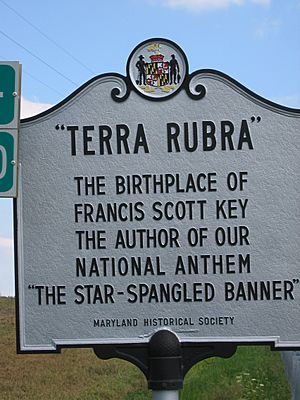
Key's father John Ross Key was a lawyer, a commissioned officer in the Continental Army, and a judge of English descent. His mother Ann Phoebe Dagworthy Charlton was born (February 6, 1756 – 1830), to Arthur Charlton, a tavern keeper, and his wife, Eleanor Harrison of Frederick in the colony of Maryland.
Key grew up on the family plantation Terra Rubra in Frederick County, Maryland (now Carroll County). He graduated from St. John's College, Annapolis, Maryland, in 1796 and read law under his uncle Philip Barton Key who was loyal to the British Crown during the War of Independence. He married Mary Tayloe Lloyd on January 1, 1802, daughter of Edward Lloyd IV of Wye House and Elizabeth Tayloe, daughter of John Tayloe II of Mount Airy and sister of John Tayloe III of The Octagon House.
"The Star-Spangled Banner"
During the War of 1812, following the Burning of Washington in August 1814, on September 7, 1814, Key and American Agent for Prisoners of War, Colonel John Stuart Skinner dined aboard HMS Tonnant as the guests of Vice Admiral Alexander Cochrane, Rear Admiral George Cockburn, and Major General Robert Ross. Skinner and Key were there to plead for the release of Dr. William Beanes, an elderly resident of Upper Marlboro, Maryland, and a friend of Key, who had been captured in his home on August 28, 1814. Beanes was accused of aiding the arrest of some British soldiers (stragglers withdrawing after the Washington campaign) who were pillaging homes. Skinner, Key, and the released Beanes were allowed to return to their own truce ship, under guard, but not allowed to leave the fleet because they had become familiar with the strength and position of the British units and their intention to launch an attack upon Baltimore. Key was unable to do anything but watch the 25-hour bombardment of the American forces at Fort McHenry during the Battle of Baltimore from dawn of September 13 through the morning of the 14th, 1814.
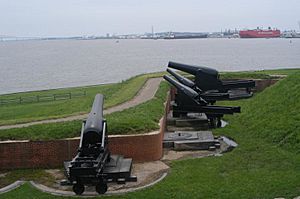
At dawn, Key was able to see a large American flag waving over the fort, and he started writing a poem about his experience, on the back of a letter he had kept in his pocket. On September 16, Key, Skinner and Beanes were released from the fleet. When they arrived in Baltimore that evening, Key completed the poem at the Indian Queen Hotel, where he was staying, His finished manuscript was untitled and unsigned. When printed as a broadside the next day, it was given the title "Defence of Fort M'Henry” with the notation: "Tune – Anacreon in Heaven" This was a popular tune that Key had already used as a setting for his 1805 song "When the Warrior Returns", celebrating American heroes of the First Barbary War. It was soon published in newspapers first in Baltimore and then across the nation, and given the new title The Star-Spangled Banner. It was somewhat difficult to sing, yet it became increasingly popular, competing with "Hail, Columbia" (1796) as the de facto national anthem by the time of the Mexican–American War and the American Civil War. The song was finally adopted as the American national anthem more than a century after its first publication by Act of Congress in 1931 signed by President Herbert Hoover.
The third verse of the Star-Spangled Banner makes disparaging mention of blacks and demonstrates Key's opinion of their seeking freedom at the time by escaping to fight with the British, who promised them freedom from American enslavement.
Legal career
Key was a leading attorney in Frederick, Maryland, and Washington, D.C., for many years, with an extensive real estate and trial practice. He and his family settled in Georgetown in 1805 or 1806, near the new national capital. He assisted his uncle Philip Barton Key in the sensational conspiracy trial of Aaron Burr and in the expulsion of Senator John Smith of Ohio. He made the first of his many arguments before the United States Supreme Court in 1807. In 1808, he assisted President Thomas Jefferson's attorney general in United States v. Peters.
In 1829, Key assisted in the prosecution of Tobias Watkins, former U.S. Treasury auditor under President John Quincy Adams, for misappropriating public funds. He also handled the Petticoat affair concerning Secretary of War John Eaton, and he served as the attorney for Sam Houston in 1832 during his trial for assaulting Representative William Stanbery of Ohio. After years as an adviser to President Jackson, Key was nominated by the President to District Attorney for the District of Columbia in 1833. He served from 1833 to 1841 while also handling his own private legal cases. In 1835, he prosecuted Richard Lawrence for his attempt to assassinate President Jackson at the top steps of the Capitol, the first attempt to kill an American president.
Key and slavery
Key purchased his first slave in 1800 or 1801 and owned six slaves in 1820. He freed seven of his slaves in the 1830s, and owned eight slaves when he died. One of his freed slaves continued to work for him for wages as his farm's foreman, supervising several slaves. Key also represented several slaves seeking their freedom, as well as several slave-owners seeking return of their runaway slaves. Key was one of the executors of John Randolph of Roanoke's will, which freed his 400 slaves, and Key fought to enforce the will for the next decade and to provide the freed slaves with land to support themselves.
Key is known to have publicly criticized slavery's cruelties, and a newspaper editorial stated that "he often volunteered to defend the downtrodden sons and daughters of Africa." The editor said that Key "convinced me that slavery was wrong—radically wrong".
Key was a founding member and active leader of the American Colonization Society (ACS), whose primary goal was to send free blacks to Africa. Though many free blacks were born in the United States by this time, historians argue that upper-class American society, of which Key was a part, could never "envision a multiracial society". The ACS was not supported by most abolitionists or free blacks of the time, but the organization's work would eventually lead to the creation of Liberia in 1847.
Death and legacy
On January 11, 1843, Key died at the home of his daughter Elizabeth Howard in Baltimore from pleurisy at age 63. He was initially interred in Old Saint Paul's Cemetery in the vault of John Eager Howard but in 1866, his body was moved to his family plot in Frederick at Mount Olivet Cemetery.
The Key Monument Association erected a memorial in 1898 and the remains of both Francis Scott Key and his wife, Mary Tayloe Lloyd, were placed in a crypt in the base of the monument.
Despite several efforts to preserve it, the Francis Scott Key residence was ultimately dismantled in 1947. The residence had been located at 3516–18 M Street in Georgetown.
Though Key had written poetry from time to time, often with heavily religious themes, these works were not collected and published until 14 years after his death. Two of his religious poems used as Christian hymns include "Before the Lord We Bow" and "Lord, with Glowing Heart I'd Praise Thee".
Key was a distant cousin and the namesake of F. Scott Fitzgerald, whose full name was Francis Scott Key Fitzgerald. His direct descendants include geneticist Thomas Hunt Morgan, guitarist Dana Key, and American fashion designer and socialite Pauline de Rothschild.
Monuments and memorials
- Francis Scott Key Monument in Baltimore. The monument was defaced in 2017 with the words "Racist Anthem" and covered in red paint.
- Two bridges are named in his honor. The first is between the Rosslyn section of Arlington County, Virginia, and Georgetown in Washington, D.C. Key's Georgetown home, which was dismantled in 1947 (as part of construction for the Whitehurst Freeway), was located on M Street NW, in the area between the Key Bridge and the intersection of M Street and Whitehurst Freeway. The location is illustrated on a sign in the Francis Scott Key park.
- The other bridge is part of the Baltimore Beltway crossing the outer harbor of Baltimore, and is located at the approximate point where the British anchored to shell Fort McHenry.
- St. John's College, Annapolis, from which Key graduated in 1796, has an auditorium named in his honor.
- Francis Scott Key was inducted into the Songwriters Hall of Fame in 1970.
- He is buried at Mount Olivet Cemetery in Frederick, the same resting place as that of Thomas Johnson, the first governor of Maryland, and friend Barbara Fritchie, who allegedly waved the American flag out of her home in defiance of Stonewall Jackson's march through the city during the Civil War.
- Francis Scott Key Hall at the University of Maryland, College Park is named in his honor. The George Washington University also has a residence hall in Key's honor at the corner of 20th and F Streets.
- Francis Scott Key High School in rural Carroll County, Maryland.
- Francis Scott Key Middle School in Houston, Texas
- Francis Scott Key Elementary School (several, including California, Maryland, Virginia, Washington, DC); Francis Scott Key School in Philadelphia.
- Francis Scott Key Mall in Frederick, Frederick County, Maryland.
- The Frederick Keys minor league baseball team – a Baltimore affiliate – is named after Key.
- The World War II Liberty ship SS Francis Scott Key was named in his honor.
- The US Navy named a submarine in his honor, the USS Francis Scott Key (SSBN-657).
- A monument to Key was commissioned by San Francisco businessman James Lick, who donated some $60,000 for a sculpture of Key to be raised in Golden Gate Park. The nation's first memorial to Francis Scott Key, the travertine monument was executed by sculptor William W. Story in Rome in 1885–87. The city of San Francisco allocated some US$140,000 to renovate the Key monument, and repairs had been finished on the monument. The statue was toppled by protesters on June 19, 2020. It has been replaced by 350 black steel sculptures—each 4 feet (1.2 meters) high—that honor the first 350 Africans kidnapped and forced onto a slave ship headed across the Atlantic from Angola in 1619. The sculptor is Dana King.
See also
 In Spanish: Francis Scott Key para niños
In Spanish: Francis Scott Key para niños


